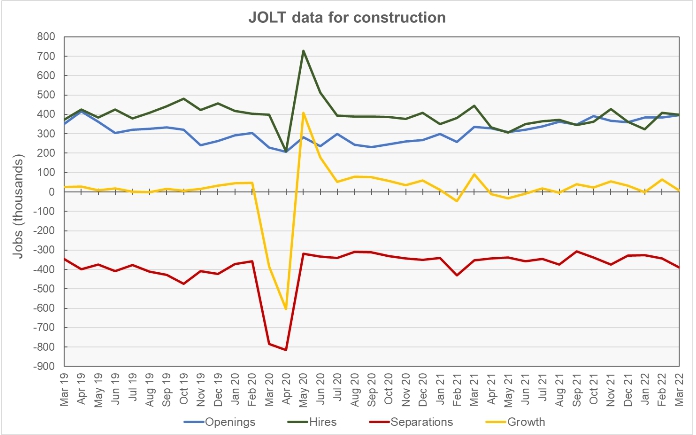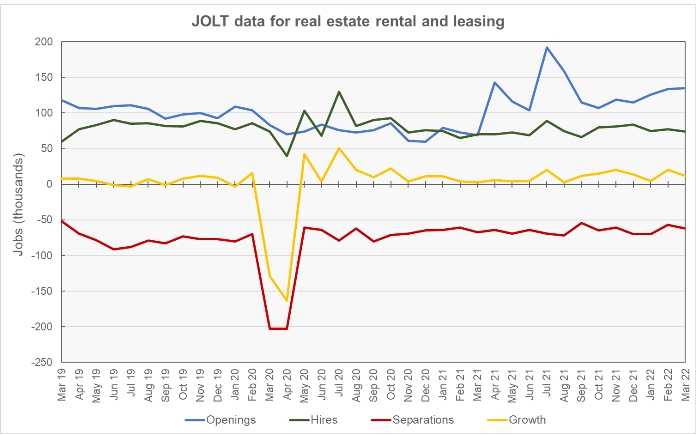The Job Openings and Labor Turnover (JOLT) report from the Bureau of Labor Statistics (BLS) said that the number of job openings hit a new record high at the end of March. Hiring was down slightly and separations rose during the month on the rising number of people quitting their jobs.
Overall jobs market shows gains
For a discussion of the JOLT report and how it relates to the Employment Situation Report, please see the paragraph at the end of this article.
The BLS reported that there were 11.55 million job openings at the end of March. This was up by 283,000 from the preliminary level of openings reported last month and was up by 205,000 openings from February’s revised figure in this month’s report.
The March job openings figure represents 7.1 percent of total employment plus job openings. For comparison, the unemployment rate in March was 3.6 percent and 6.0 million people were unemployed. Another 5.7 million people said that they would like a job but were not counted as being in the labor force since they were not actively seeking employment.
The number of people hired for a new job in March was 6.74 million, while the number of people leaving their old jobs was 6.32 million. Of those leaving their jobs, 4.53 million quit voluntarily, a new record high for the series, while 1.41 million people were involuntarily separated from their jobs. The remainder of people leaving their jobs left for other reasons, such as retirements or transfers. The portion of people quitting their jobs rose slightly to 3.0 percent of the labor force. The involuntary separations rate was unchanged at 0.9 percent.
Construction hiring outpaces separations
The first chart, below, shows the employment situation for the construction jobs market over the last 37 months. It shows that March saw a net increase of 9,000 jobs. In addition, February’s job gains were revised upward from 54,000 jobs gained to 64,000 jobs gained.

Construction jobs openings in March were reported to be 396,000 jobs, 18 percent higher than the year-earlier level. On a month-over-month basis, openings for construction jobs were reported to rise by 13,000 openings from February’s revised (+2,000) jobs opening figure. Job openings in the construction category represent 4.9 percent of total employment plus job openings.
Hiring was reported to be down by 10,000 jobs in March, but only because February’s hiring figure was revised upward. The actual hiring figure reported for March was 398,000 new hires, the same as the preliminary figure reported for February in last month’s report. The number of construction jobs that were filled in March was reported to be down 2.5 percent month-over-month and down 10.4 percent year-over-year.
Construction jobs separations were reported to rise by 45,000 jobs in March to 389,000 jobs. This was the second month in a row of significantly higher job separations. Quits were reported to rise by 69,000 jobs from February’s revised (+4,000 jobs) figure to a level of 242,000 jobs. Layoffs were reported to fall by 36,000 to 121,000 jobs. “Other separations” which includes retirements and transfers, were reported rise by 12,000 jobs from February’s revised (-6,000 jobs) figure to 26,000 jobs. Quits represented 62 percent of separations for the month.
RERL jobs growth continues positive
The last chart, below, shows the employment situation for the real estate and rental and leasing (RERL) jobs category. Employment growth in this jobs category was 12,000 jobs. Employment growth has been positive for this jobs category ever since May 2020.

The number of job openings in the RERL category was 135,000 jobs at the end of March, up 1,000 jobs from the revised level (-3,000 openings) of the month before. Job openings in March were 66 percent higher than their year-earlier level. Job openings in the RERL category represent 5.4 percent of total employment plus job openings.
Hiring in March was down by 3,000 jobs from February’s revised (+5,000 jobs) level at 74,000 jobs. This hiring figure was 4 percent above the year-earlier level.
Separations in the RERL jobs category in March were up from February’s revised (+2,000 jobs) figure at 62,000 jobs. Quits were unchanged from February’s revised (+3,000 jobs) figure at 43,000 jobs. Quits represented 69 percent of total separations in March.
The numbers given in the JOLT report are seasonally adjusted and are subject to revision. It is common for small adjustments to be made in subsequent reports, particularly to the data for the most recent month. The full current JOLT report can be found here.
Comparing the reports
The US labor market is very dynamic with many people changing jobs in any given month. The JOLT report documents this dynamism by providing details about job openings, hiring and separations. However, it does not break down the jobs market into as fine categories as does the Employment Situation Report, which provides data on total employment and unemployment. For example, while the Employment Situation Report separates residential construction from other construction employment, the JOLT report does not. The Employment Situation Report separates residential property managers from other types of real estate and rental and leasing professionals, but the JOLT report does not. However, the JOLT report provides a look at what is driving the employment gains (or losses) in broad employment categories.










